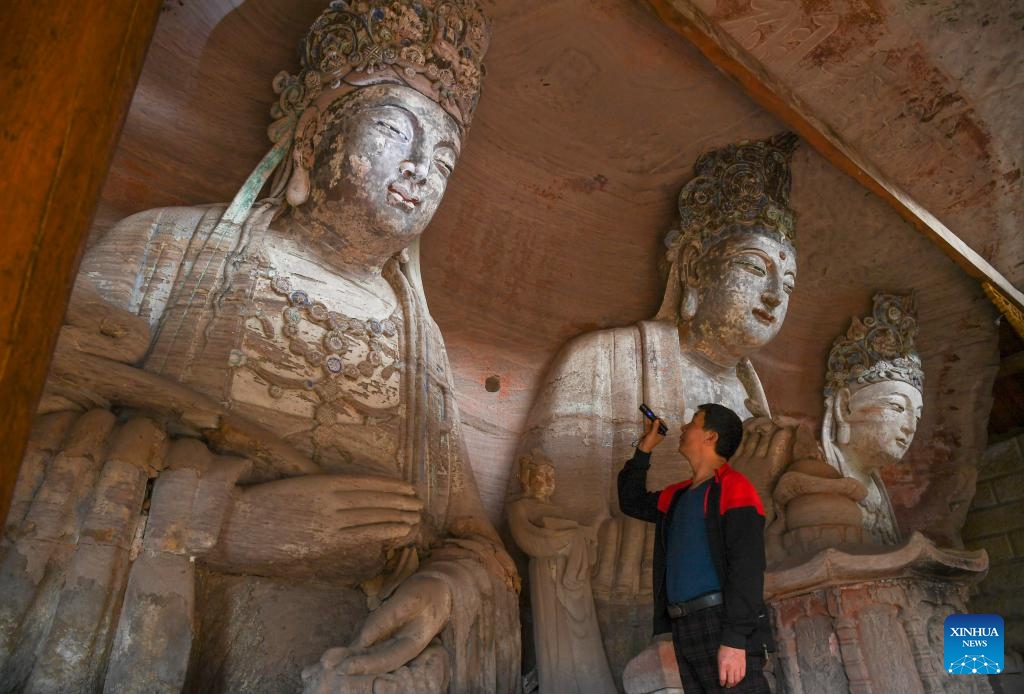
A volunteer conducts an inspection tour at a cultural relics protection site of Dazu Rock Carvings in Baoding Town of Dazu District, southwest China's Chongqing Municipality, Oct. 31, 2023. Dazu Rock Carvings originated from Sichuan and Chongqing regions in ancient China. In 1999, the carvings were added to the UNESCO World Heritage List as a cultural heritage site.(Photo: Xinhua)
During the two sessions, many of China's political advisors from the realms of cultural relics stressed the significance of protecting and utilizing cultural relics and their role in cultural inheritance and development.
According to the National Cultural Heritage Administration (NCHA), the 2024 Chinese Government Work Report released during the two sessions proposes for the first time to "strengthen the systematic protection and rational use of cultural relics," reflecting the dialectical unity of inheritance and development.
In terms of better utilization of cultural relics, Chinese Deputy Minister of Culture and Tourism Li Qun, a standing committee member of the National Committee of the Chinese People's Political Consultative Conference (CPPCC) and head of the NCHA, told the Global Times that the country will strive to build world-class museums with Chinese characteristics and construct an exhibition and display system for Chinese civilization.
Besides optimizing free admission and public services at museums, the administration also plans to further deepen cooperation mechanisms between museums and research institutes such as universities and colleges.
Li further pointed out that regarding cultural relics, protection is a prerequisite for utilization, and it is essential to adhere to a protection-first principle. Utilization is the transformation of the results of protection, which leads to the innovative development of Chinese excellent traditional culture and the invigoration of its vitality.
To strengthen the systematic protection and utilization of cultural relics, the administration will focus on improving the legal and regulatory system for cultural relic protection and advancing cultural relic protection management mechanisms through concrete plans such as the Fourth National Survey of Cultural Relics.
Meanwhile, at a consultation meeting for the religious sector on "Strengthening the Protection and Utilization of Cultural Relics at Religious Sites" held on Thursday by the National Committee of the CPPCC, many attendees reached the consensus that some religious sites and their cultural relics need further development and utilization as the rich cultural and historical connotations of these sites are yet to be fully explored. Additionally, issues such as insufficient funding for the maintenance and protection of immovable cultural relics like ancient buildings and a shortage of professional talents, still exist.
Guan Qiang, deputy head of the NCHA, pointed out that the NCHA places great emphasis on the protection, utilization, and management of cultural relics at religious sites such as Taoist temples and churches.
With the launch of the Fourth National Survey of Cultural Relics, the administration will step up its efforts to survey and identify cultural relic resources at religious sites, such as establishing catalogs of a large database for immovable cultural relic resources related to religious sites, Guan noted.
In addition to the preservation and protection of the cultural relics at these religious sites, the administration also encourages the full exploration of the cultural and historical value and connotations of these sites. Through diverse exhibitions and events held at these sites, the role of cultural relics at religious sites is expected to be better leveraged regarding cultural inheritance and social education.




